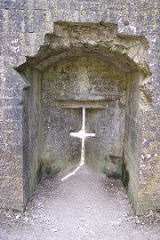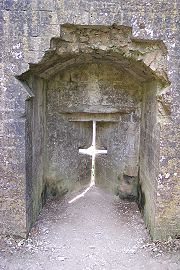
Balistraria
Encyclopedia

Fortification
Fortifications are military constructions and buildings designed for defence in warfare and military bases. Humans have constructed defensive works for many thousands of years, in a variety of increasingly complex designs...
through which an archer
Archery
Archery is the art, practice, or skill of propelling arrows with the use of a bow, from Latin arcus. Archery has historically been used for hunting and combat; in modern times, however, its main use is that of a recreational activity...
can launch arrow
Arrow
An arrow is a shafted projectile that is shot with a bow. It predates recorded history and is common to most cultures.An arrow usually consists of a shaft with an arrowhead attached to the front end, with fletchings and a nock at the other.- History:...
s.
The interior walls behind an arrow loop are often cut away at an oblique angle so that the archer has a wide field of view
Field of view
The field of view is the extent of the observable world that is seen at any given moment....
and field of fire. Arrow slits come in a remarkable variety. A common and recognizable form is the cross
Cross
A cross is a geometrical figure consisting of two lines or bars perpendicular to each other, dividing one or two of the lines in half. The lines usually run vertically and horizontally; if they run obliquely, the design is technically termed a saltire, although the arms of a saltire need not meet...
. The thin vertical aperture permits the archer large degrees of freedom to vary the elevation
Elevation (ballistics)
In ballistics, the elevation is the angle between the horizontal plane and the direction of the barrel of a gun, mortar or heavy artillery. Originally, elevation was a linear measure of how high the gunners had to physically lift the muzzle of a gun up from the gun carriage to hit targets at a...
and direction of his bowshot but makes it difficult for attackers to harm the archer since there is only a small target to aim at.
Balistraria can often be found in the curtain walls
Curtain wall (fortification)
A curtain wall is a defensive wall between two bastions of a castle or fortress.In earlier designs of castle the curtain walls were often built to a considerable height and were fronted by a ditch or moat to make assault difficult....
of medieval battlements beneath the crenellations.
History
The invention of the arrowslit is attributed to ArchimedesArchimedes
Archimedes of Syracuse was a Greek mathematician, physicist, engineer, inventor, and astronomer. Although few details of his life are known, he is regarded as one of the leading scientists in classical antiquity. Among his advances in physics are the foundations of hydrostatics, statics and an...
during the siege of Syracuse in 214–212 BC. Slits "of the height of a man and about a palm's width on the outside" allowed defenders to shoot bows and scorpions (an ancient siege engine) from within the city walls. Although used in late Greek and Roman defences, arrowslits were not present in early Norman castle
Castle
A castle is a type of fortified structure built in Europe and the Middle East during the Middle Ages by European nobility. Scholars debate the scope of the word castle, but usually consider it to be the private fortified residence of a lord or noble...
s. They are only reintroduced to military architecture towards the end of the 12th century, with the castles of Dover
Dover Castle
Dover Castle is a medieval castle in the town of the same name in the English county of Kent. It was founded in the 12th century and has been described as the "Key to England" due to its defensive significance throughout history...
and Framlingham
Framlingham Castle
Framlingham Castle is a castle in the market town of Framlingham in Suffolk in England. An early motte and bailey or ringwork Norman castle was built on the Framlingham site by 1148, but this was destroyed by Henry II of England in the aftermath of the revolt of 1173-4...
in England, and Richard the Lionheart's
Richard I of England
Richard I was King of England from 6 July 1189 until his death. He also ruled as Duke of Normandy, Duke of Aquitaine, Duke of Gascony, Lord of Cyprus, Count of Anjou, Count of Maine, Count of Nantes, and Overlord of Brittany at various times during the same period...
Château Gaillard in France. In these early examples, arrowslits were positioned to protect sections of the castle wall, rather than all sides of the castle. In the 13th century, it became common for arrowslits to be placed all around a castle's defences.
Design
In its simplest form, an arrowslit was a thin vertical opening; however, the different weapons used by defenders sometimes dictated the form of arrowslits. For example, openings for longbowmenEnglish longbow
The English longbow, also called the Welsh longbow, is a powerful type of medieval longbow about 6 ft long used by the English and Welsh for hunting and as a weapon in medieval warfare...
were usually tall and high to allow the user to shoot standing up and make use of the 6 ft (1.8 m) bow, while those for crossbowmen were usually lower down as it was easier for the user to shoot whilst kneeling to support the weight of the weapon. It was common for arrowslits to widen to a triangle at the bottom, called a fishtail, to allow defenders a clearer view of the base of the wall. Immediately behind the slit there was a recess called an embrasure
Embrasure
In military architecture, an embrasure is the opening in a crenellation or battlement between the two raised solid portions or merlons, sometimes called a crenel or crenelle...
; this allowed a defender to get close to the slit without being too cramped. The width of the slit dictated the field of fire, but the field of vision could be enhanced by the addition of horizontal openings; they allowed defenders to view the target before it entered range.
Usually, the horizontal slits were level, which created a cross shape, but less common was to have the slits off-set (called displaced traverse slots) as demonstrated in the remains of White Castle
White Castle (Wales)
White Castle is a medieval castle located in Monmouthshire, Wales. The name "White Castle" was first recorded in the thirteenth century, and was derived from the whitewash put on the stone walls. The castle was originally called Llantilio Castle , after Llantilio Crossenny, the mediæval manor of...
in Wales. This has been characterised as an advance in design as it provided attackers with a smaller target; however, it has also been suggested that it was to allow the defenders of White Castle to keep attackers in their sights for longer because of the steep moat
Moat
A moat is a deep, broad ditch, either dry or filled with water, that surrounds a castle, other building or town, historically to provide it with a preliminary line of defence. In some places moats evolved into more extensive water defences, including natural or artificial lakes, dams and sluices...
surrounding the castle.
When an embrasure linked to more than one arrowslit (in the case of Dover Castle
Dover Castle
Dover Castle is a medieval castle in the town of the same name in the English county of Kent. It was founded in the 12th century and has been described as the "Key to England" due to its defensive significance throughout history...
, defenders from three embrasures can shoot through the same arrowslit) it is called a "multiple arrowslit". Some arrowslits, such as those at Corfe Castle
Corfe Castle
Corfe Castle is a village and civil parish in the English county of Dorset. It is the site of a ruined castle of the same name. The village and castle stand over a gap in the Purbeck Hills on the route between Wareham and Swanage. The village lies in the gap below the castle, and is some eight...
, had lockers nearby to store spare arrows and bolts; these were usually located on the right hand side of the slit for ease of access and to allow a rapid rate of fire.

